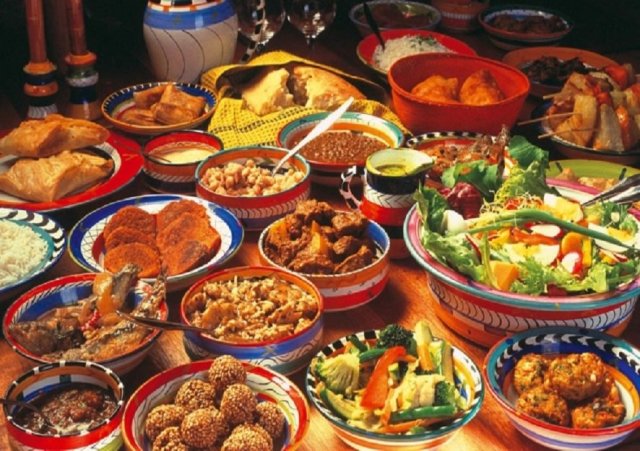The cuisine of East Africa varies from area to area. In the inland savannah, the traditional cuisine of cattle-keeping peoples is distinctive in that meat products are generally absent. Cattle, sheep, pigs and goats were regarded as a form of currency and a store of wealth, and are not generally consumed as food.
In some areas, traditional East Africans consume the milk and blood of cattle, but rarely the meat. Elsewhere, other peoples are farmers who grow a variety of grains and vegetables. Maize (corn) is the basis of ugali, the local version of West and Central Africa's fufu. Ugali is a starch dish eaten with meats or stews. In Uganda, steamed green bananas called matoke provide the starch filler of many meals.
Eritrean and Ethiopian food habits vary regionally. In the highlands, injera is the staple diet and is eaten daily among the Tigrinya. Injera is made out of teff, wheat, barley, sorghum or corn, and resembles a spongy, slightly sour pancake. When eating, diners generally share food from a large tray placed in the center of a low dining table. Many injera are layered on this tray and topped with various spicy stews. Diners then break into the section of injera in front of them, tearing off pieces and dipping them into the stews.
The cooking of Southern Africa is sometimes called "rainbow cuisine", as the food in this region is a blend of many cultures: indigenous African societies, European, and Asian. The diet reflected in the universal Southern African love of barbecue (generally called in South Africa by its Afrikaans name, a "braai") and biltong (dried preserved meat). The traditional beer was ubiquitous in the southern African diet, and the fermentation added additional nutrients.
Milk was historically one of the most important components of the southern African diet. Cattle were considered a man's most important possession, and in order to marry, a man had to compensate his prospective in-laws with a gift of cattle as a dowry for his bride. A married man was expected to provide a generous supply of milk to his wife and children, along with meat whenever he slaughtered cattle, sheep or goats. Because there was no refrigeration, most milks was soured into a kind of yogurt.

